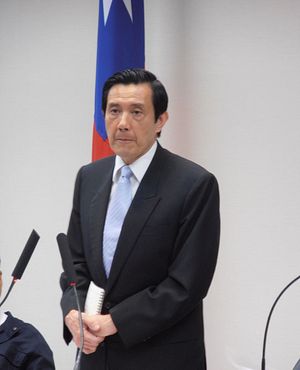Most have assumed that China’s establishment of an Air Defense Identification Zone (ADIZ) in the East China Sea is aimed at Japan the bilateral dispute over the Diaoyu/Senkaku Islands. There’s good reason for this: China has apparently said as much.
Although China at first claimed that the ADIZ was not aimed at any particular country, when it was asked by South Korea to redraw the lines of the ADIZ Chinese officials reportedly responded by assuring their counterparts in Seoul that the ADIZ was aimed at Japan not South Korea.
Many of China’s harshest responses to criticism over the East China Sea ADIZ have been directed at Japan as well. For example, last week a Chinese Defense Ministry spokesperson said: “Japan has absolutely no right to make irresponsible comments regarding China setting up the East China Sea ADIZ. We would like to ask Japan to revoke its own ADIZ first, China will then consider this request in 44 years.” Then there’s the fact that China has been waging an unrelenting campaign to isolate Japan from the region, along with the Philippines.
In all reality, the East China Sea ADIZ is likely aimed in no small part at Japan in general and the Senkaku Islands in particular. Still, there’s another more important factor at play here for China: Taiwan.
Second Line of Defense’s Robbin Laird and Ed Timperlake have a characteristically perceptive article on the new ADIZ, and how Taiwan fits into the equation. Laird and Timperlake analyze the East China Sea ADIZ through the lens of the strategic quadrangle concept they develop in their new book: Rebuilding American Military Power in the Pacific A 21st-Century Strategy.
The strategic quadrangle is an enormous expanse of (mostly) water that stretches from Singapore to South Korea to Japan and back down to Australia. The distances involved in this quadrangle are “daunting,” they note: “It is nearly 4,000 miles from Japan to Australia. It is nearly 2,500 miles from Singapore to Australia and nearly 3,000 miles from Singapore to South Korea.”
The only thing that may outmatch the sheer size of the quadrangle is its importance to the U.S. and allied forces. As Laird and Timperlake explain in the article, “[The strategic quadrangle] is a central area where the U.S. and several core allies are reaching out to shape collaborative defense capabilities to ensure defense in depth…. Freedom to operate in the quadrangle is a baseline requirement for allies to shape collaborative capabilities and policies. Effectiveness can only emerge from exercising evolving forces and shaping convergent concepts of operations.”
Notably, China’s ADIZ falls directly within this quadrangle, as does Taiwan. This may not be a coincidence. With the East China ADIZ, Laird and Timperlake warn, “The PRC is putting down its marker onto the quadrangle and if not dealt with will undoubtedly expand its definitions of air and maritime defense outward.”
More ominously, they write, “We have placed the ADIZ down upon the strategic geography we have identified and a key reality quickly emerges. Just by chance the zone covers reinforcements to Taiwan.” That is, the ADIZ happens to cover the exact areas that the U.S. or Japan would have to traverse in order to promptly respond to a PLA invasion of Taiwan.
Thus, if China can deny U.S. and allied forces the ability to operate in the waters and airspace covered by the ADIZ, the U.S. would be unable to use its immense military resources in South Korea and Japan in defense of Taiwan. Instead, the U.S. military would have to travel from Guam, the Philippines and other nations located around the South China Sea (until China establishes an ADIZ over that body of water as well). This is where the tyranny of distance really weighs heavily on U.S. forces.
It’s worth noting, in this context, that China has demanded that aircraft flying in the East China Sea ADIZ identify themselves even when their destination is not the Chinese mainland. This is different from most nations’ ADIZs, which only require aircraft identify themselves if they intend to enter national airspace.
Notably, soon after China declared the East China Sea ADIZ last month, its sole aircraft carrier, Liaoning, passed through the Taiwan Strait on its way to the South China Sea. The Director-General of Taiwan’s National Security Bureau, Tsai Der-sheng, said this week that the Liaoning’s passage through the strait demonstrated that there was an inevitable imbalance of military forces between China and Taiwan. At the same time, Tsai told Taiwan’s parliament that the country is prepared to use force to protect its ADIZ. Thus, far Taiwan has joined with South Korea, Japan, and the United States in defying China’s new ADIZ.
As my colleague Shannon pointed out last week, China’s historic claims to the Diaoyu/Senkaku Islands rest on it being part of Taiwan. Thus, were China to gain control over the disputed islands, it would effectively be controlling part of Taiwan.
Perhaps in deference to Taiwan’s sensitivity, according to a map on Wikipedia, China’s ADIZ doesn’t include Yonaguni Island, which belongs to Japan but is located just 70 miles from Taiwan and falls within Taipei’s ADIZ. In recent years, Japan has been boosting the presence of Self-Defense Forces on Yonaguni, which many believe is part of an effort by Tokyo to assist Washington in protecting Taiwan. Articles in Chinese state media this week have railed against Japan for expanding its own ADIZ in 2010 to include Yonaguni Island.

































